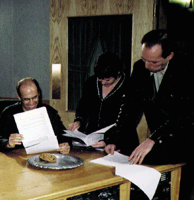Paving the Musical Road to El Dorado
(continued from page 2)
 |
|
The Road
to El Dorado may indeed lead right to gold for Sir Elton
John with another big hit song and video. TM & ©
2000 DreamWorks LLC.
|
Animation versus Live-Action
Radford says that working with music
for animation is very similar to working with music for live-action
films in that it's all about pre-production. The same types of decisions
-- things like tempo, duration and who will sing the song -- have
to be made in both mediums in order to shoot the scene to the music.
But, she adds, there are some unique opportunities in music for
animation: "[Animation] is a place for an abundance of original
music. This is not so in live-action. This has to do with the MTV
generation. It's clear that the movie-going audience has been raised
solely on MTV. Their impression of visual music is radically different
than any previous generation."
Powell explains another difference between working
on animation and live-action: "Normally, in an animated film, it's
all worked out so much that they're really not going to change the
edit around. Although, El Dorado was an example where the
edit was changing pretty much up to the last minute. In live-action...you
can have complete re-edits going on from day to day. As a composer,
you're writing on a film that's never stationary and that's very
difficult."
 |
|
Executive producer
Jeffrey Katzenberg reads over a script with music supervisor
Marylata Jacob and Composer Hans Zimmer (left to right). Courtesy
of DreamWorks LCC.
|
In a League of Its Own
When asked to compare working on the
music for El Dorado to her work on other DreamWorks features,
Marylata Jacob comments, "Antz was not a musical, yet
there were musical moments. It was fun to put in redone commercial
songs, which hadn’t been done before." Jacobs explains
that making fellow musical The Prince of Egypt was vastly
different from El Dorado. She says, "Prince of Egypt
was really classic. We used well over a 100-piece orchestra. It
was epic. We had large choirs. The visuals were showing 400,000
slaves leaving, which was depicted in a very grand, epic way, musically."
El Dorado, she says, is on the other end of the spectrum.
"Musically, it’s small. Hans' themes are very intimate.
We didn't use big orchestras at all. The featured instrument is
acoustic guitar, and then marimbas."
And of course there's that armadillo instrument,
the churango. Clearly, the process of creating music for animation,
making the necessary changes, and then actually matching the music
to the film is quite an intricate task. Playing armadillo over an
armadillo is just one decision, clever as it may be. And speaking
of inside jokes, though the animal is not named in the film, the
musicians and animators called the armadillo Bibo, after co-director
Bibo Bergeron.
Sharon Schatz is a writer for a popular children’s
television Web site and is also a freelance writer based in Los
Angeles.

